To participate in drone racing competitions, you need to follow essential guidelines. Begin with your drone specifications: keep the frame under 305mm and use propellers no larger than 6 inches. Make certain your drone has at least four LEDs for visibility and join organizations like the AMA for registration. Safety is vital, so conduct pre-race checks and wear protective gear. Races typically use a heat format, scoring based on the fastest three consecutive laps. Each team must include at least three pilots, with their performance determining qualification for championships. There's much more to explore about strategies and equipment to enhance your experience.
Overview of Drone Racing Rules
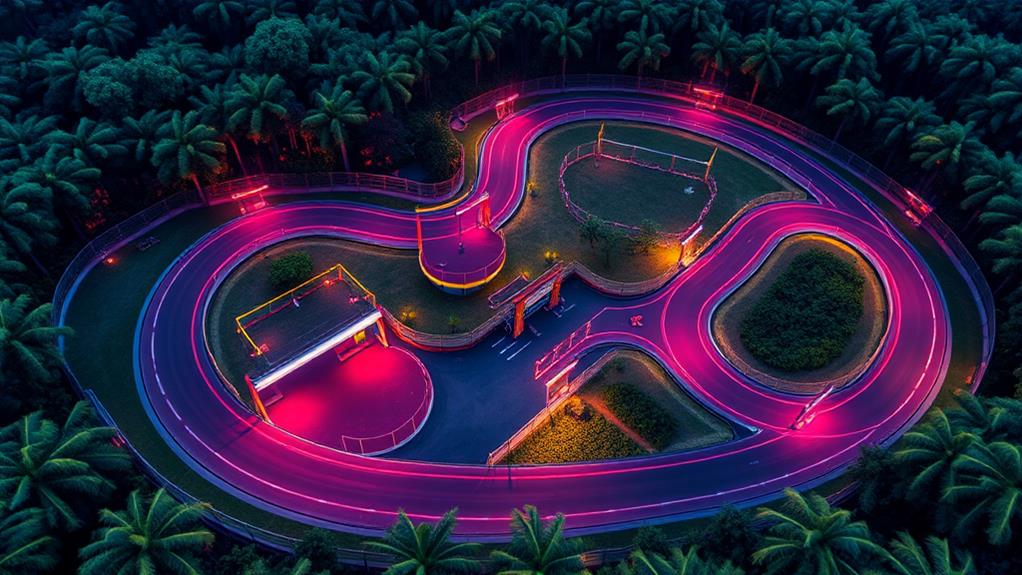
When you immerse yourself in drone racing competitions, you'll quickly find that understanding the rules is essential for success. These rules govern everything from the specifications of your racing drones to the qualifications needed to compete.
For instance, each racing drone must adhere to specific technical requirements, including a maximum frame size of 305mm, a maximum battery cell count of 6, and propellers not exceeding 6 inches in size. Selecting beginner-friendly models can also enhance your experience as you learn to navigate these regulations with ease, ensuring a smoother introduction to the sport. As you grow in skill, mastering flight basics will be vital for effective competition mastering flight basics.
As a drone racer, you'll also need to use the required video transmitters, like 25mw Raceband or HDZero, especially for National Championship events, ensuring compliance with competition standards.
Don't forget about visibility; each drone must have a minimum of 4 LEDs, with RGB switchable options highly encouraged.
You can form a team with an unlimited number of pilots, but only the top three scores from your team will count towards qualification.
Finally, you must register through designated links and hold necessary memberships, such as the Academy of Model Aeronautics (AMA), to be eligible for racing events.
Equipment Specifications for Competitions
Understanding the equipment specifications for drone racing competitions is essential for any aspiring pilot. To compete effectively, your racing drone must adhere to a maximum frame size of 305mm. This guarantees agility and speed, critical for maneuvering tight courses.
The choice of materials, such as carbon fiber for lightweight durability, can further enhance your drone's performance in races, as noted in frame material and design. You can utilize up to six battery cells for peak performance, which can greatly enhance your flight time and power.
Propellers are another important component; they shouldn't exceed six inches in size. Larger propellers can hinder your drone's maneuverability.
For video transmission, competitors are required to use video transmitters with a minimum power output of 25mw, specifically tuned to the Raceband or HDZero frequency during National Championship events.
Additionally, each racing drone must be equipped with at least four LEDs. These lights improve visibility and safety, especially during night races; adding RGB switchable options can make your drone stand out even more.
Finally, while wearing your FPV goggles, always verify your equipment complies with all safety regulations outlined by the governing bodies. Pre-race checks are essential to confirm that all components are functioning correctly.
Following these specifications will help you compete effectively in the Drone Racing League.
Safety Protocols for Pilots
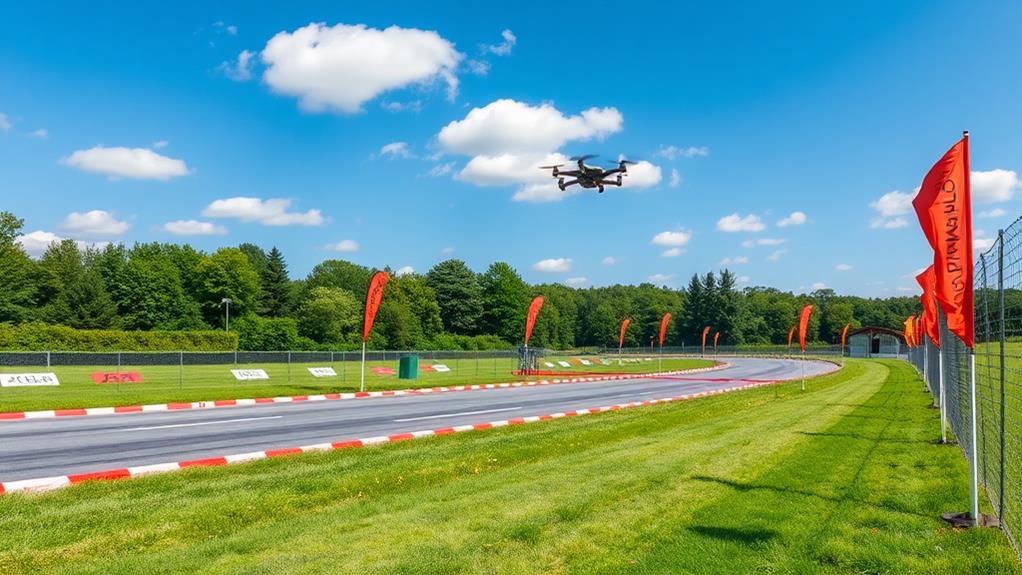
Before you take to the skies, it's essential to conduct thorough pre-race safety checks on your equipment. This means inspecting your drone's battery and ensuring everything is functioning properly to prevent mechanical failures.
Additionally, familiarizing yourself with local UAV regulations can help you avoid legal complications during your racing experience.
Plus, understanding emergency response procedures can help you act swiftly if something unexpected happens during the race.
Pre-Race Safety Checks
Conducting pre-race safety checks is crucial to guaranteeing a smooth and secure drone racing experience.
Before you take to the sky, it's imperative to inspect your drone thoroughly. This not only enhances performance but also guarantees your safety and that of fellow pilots.
Here are four key pre-race checks you should perform:
- Inspect the Frame: Look for any damaged parts and confirm all components are tightly secured. Loose components can lead to crashes.
- Test Electronic Systems: Make sure your FPV cameras, video transmitters, and receivers are functioning correctly. Technical failures can ruin your race.
- Check Racing Regulations: Confirm your drone complies with racing regulations, like the maximum frame size of 305mm and the required LED configurations. This helps avoid penalties.
- Set Video Transmitters: Before takeoff, verify that your video transmitters are set to the assigned channels. This prevents interference with other competitors' feeds.
Emergency Response Procedures
In the fast-paced world of drone racing, being prepared for emergencies is as vital as having a well-tuned drone. Each racing event comes with its own unique challenges, so you must familiarize yourself with the emergency response plan specific to the venue. This plan outlines procedures for accidents or equipment failures that may occur during the race.
Immediate communication with race officials is essential if your drone crashes or experiences a malfunction. This guarantees that safety protocols are enacted without delay.
Additionally, every drone pilot must have a designated spotter present during races. This person helps with situational awareness and addresses any potential hazards on the course.
Wearing proper safety gear, such as helmets and gloves, minimizes your risk of injury in the event of a collision or crash.
Regular participation in safety briefings before races keeps you updated on any changes in emergency procedures and protocols relevant to each event.
Race Format and Procedures
Drone racing competitions are thrilling events where pilots showcase their skills on intricate courses filled with obstacles. Understanding the race format and procedures is essential for both participants and spectators.
Typically, drone races are structured in heats, allowing multiple pilots to compete simultaneously. Here's a breakdown of the race format:
- Heats and Elimination: Races progress through elimination rounds, starting with heats and advancing to quarter-finals, semi-finals, and finally, the championship heat.
- Lap Timing: Timing for each lap begins and ends at the start/finish gate. Pilots must complete a minimum number of laps to qualify for scoring.
- Scoring System: Each pilot's performance is based on their fastest three consecutive lap times, with scoring calculated using the formula: score = 100 / time. This means faster times earn higher scores.
- Team and Individual Formats: Competitions often include both formats, where only the top three scores from each team contribute to their overall ranking for championship qualifications.
Scoring Systems Explained
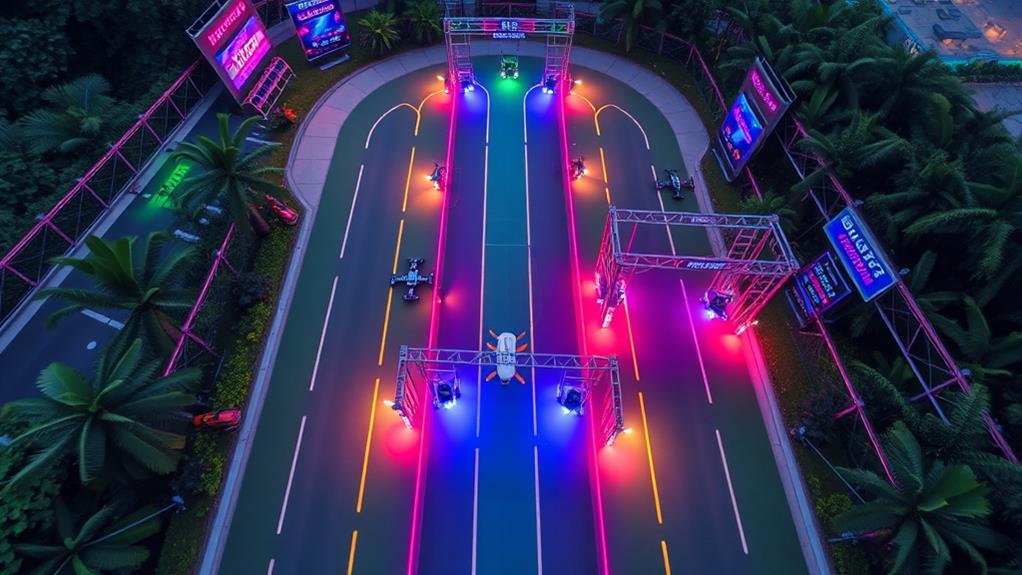
Understanding scoring systems in drone racing is essential for both pilots and fans alike. In this high-speed racing environment, pilots submit their fastest three consecutive lap times after each flying day. Timing starts and ends at the start/finish gate, ensuring each pilot's performance is accurately recorded. To maintain precision in scoring, either a designated spotter or onboard DVR tracks the lap times.
The scoring formula is straightforward: score = 100 / time. This means that faster lap times yield higher scores for pilots, rewarding skill and speed.
After a month, team scores are calculated by summing the top three pilot scores from that team, with no cap on the number of pilots allowed. This allows teams to maximize their scoring potential.
To qualify for championships, the top 10 teams are determined based on the cumulative scores of their best three pilots by the end of January. This scoring system encourages not just individual excellence but teamwork, as pilots work together to elevate their team's overall performance.
Understanding these scoring dynamics helps everyone involved appreciate the competitive nature of drone racing and the strategies pilots use to succeed.
Team Registration Guidelines
When you're ready to register your team for drone racing competitions, you'll need to follow specific guidelines to guarantee everything runs smoothly.
First, make certain you have the right team composition, as the top three pilots' scores will be vital for qualification.
Understanding the registration process and qualification criteria is essential for maximizing your team's chances of success and making it to the championships.
Team Composition Requirements
To kick off your journey in drone racing competitions, it's vital to grasp the team composition requirements. Understanding how your team is structured can greatly impact your performance and chances of qualifying for championships.
Here are some key points to keep in mind:
- Flexible Team Size: There's no maximum number of pilots allowed per team. However, only the top three scores from your pilots will count toward overall standings.
- Minimum Participation: If your team has fewer than three pilots, only the scores of the participating members will be taken into account. This can limit your scoring potential.
- Monthly Score Calculation: Team scores are calculated monthly, based on the top three pilot scores submitted. This means consistent performance is essential.
- Championship Qualification: At the end of January, the top 10 teams are invited to championships based on the cumulative scores of their top three pilots.
Registration Process Steps
Registering your team for drone racing competitions is a straightforward process that guarantees you're officially listed to compete. To begin, you'll need to access the designated registration link provided by the event organizers. Make certain to fill out all required information accurately, as this guarantees your team's inclusion in the official roster.
Remember, there's no limit to the number of pilots on your team, but only the top three scores from your drone operators will count toward qualification standings. This scoring system encourages consistent participation and improvement, as teams are evaluated monthly based on their top three pilots' cumulative performance.
Additionally, each team can bring up to six pilots to the competitions, but you must guarantee all members possess the necessary AMA (Academy of Model Aeronautics) membership to participate. This membership is essential for compliance with competition regulations.
Lastly, to qualify for championship events, the top ten teams will be invited based on the sum of their top three pilots' scores by the end of January. So, stay sharp, and get your registration done early to secure your spot in the exciting world of drone racing!
Qualification Criteria Overview
Understanding the qualification criteria is essential for your team's success in drone racing competitions. To compete effectively, you need to be aware of the specific guidelines that shape your preparation and strategy.
Here are the key points to keep in mind for team registration:
- Registration Process: Verify your team registers via the designated link to validate your documentation and eligibility.
- Pilot Limit: You can have up to six pilots on your team, but only the top three pilot scores will contribute to your team's overall qualification score.
- Qualification Timeline: The qualification for the Championship depends on the sum of the top three pilot scores, with evaluations ending in January. The top 10 teams will be invited based on these scores.
- Membership Requirement: All participants must hold a valid AMA (Academy of Model Aeronautics) membership to participate in the competition.
Additional spots may be available through special invitations from other tournaments or leaderboard standings.
Staying informed and preparing your team accordingly will enhance your chances of success in the thrilling world of drone racing!
Post-Race Evaluation Practices
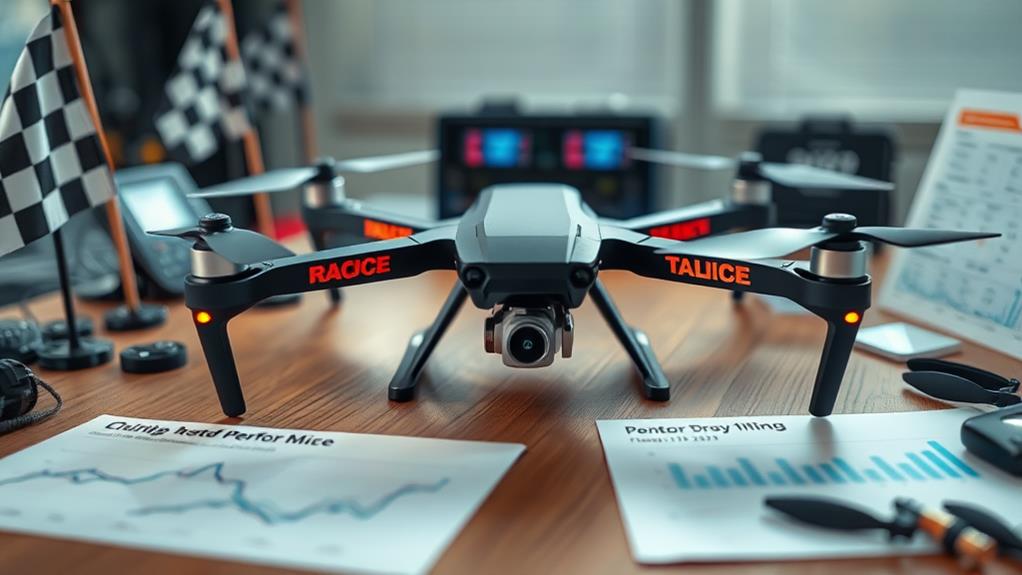
After a drone racing competition, conducting a thorough debriefing session is vital for pilots looking to enhance their performance.
Begin with post-race discussions where you and your fellow racers can share insights about your strategies. Talking through what worked and what didn't can reveal new perspectives and strengthen your community support.
Next, take time to evaluate race footage. This step is significant, as reviewing your piloting techniques and decision-making processes helps identify mistakes. By learning from your experiences, you can refine your skills for future events.
Additionally, don't forget to inspect your equipment after the race. Look for any signs of damage or wear to guarantee your drone is in top shape for upcoming competitions. Proper maintenance is key to reliable performance.
Conclusion
In summary, understanding the vital guidelines for drone racing is critical for anyone looking to compete. Did you know that the average drone racing pilot can reach speeds of up to 100 miles per hour? This thrilling aspect of the sport highlights the importance of adhering to safety protocols and equipment specifications. By following these guidelines and keeping the competitive spirit alive, you can guarantee a successful and enjoyable racing experience. Get ready to take flight and join the excitement!
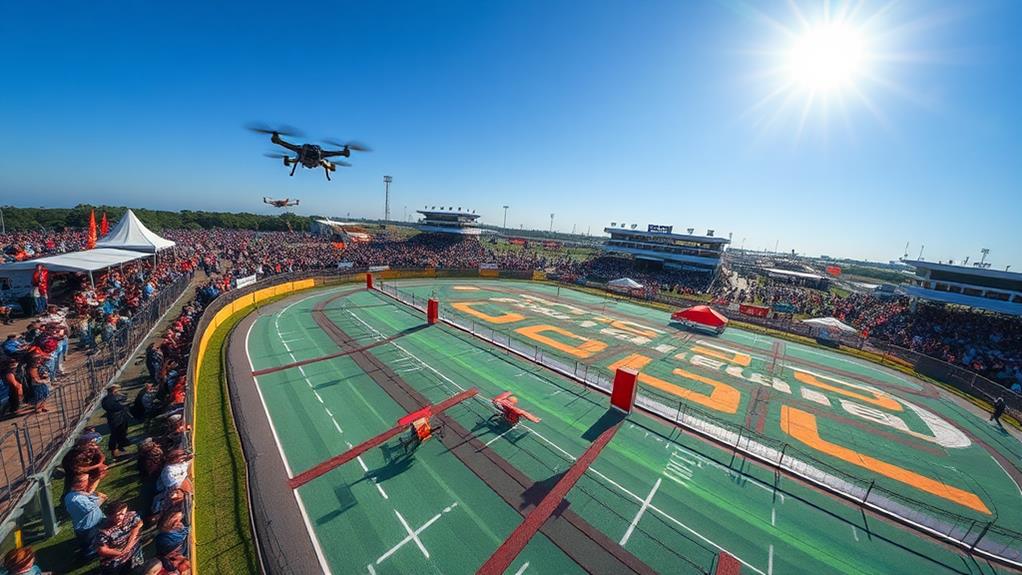
Leave a Reply